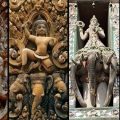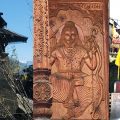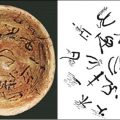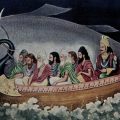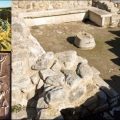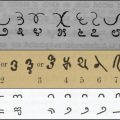Vedic Cultural Origins of South American Civilizations: The Makara Link
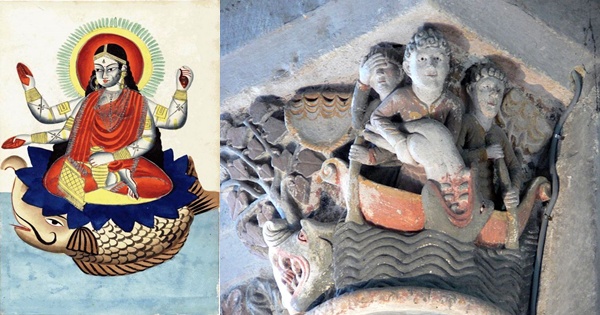
A few years ago, after having seen images from Richard Cassaro online, and after reading his subsequent article “suppressed by scholars” published on his website in 2012, where he points out similarities between Balinese and Maya civilizations, I started researching this particular subject in depth. For over 200 years many authors have been pointing out the transpacific cultural links in various publications. It’s a continuous quest to keep up with information provided by other scholars and yet being unique by expanding on such theories by trying to present more, unique and deeper research.
My research has resulted in an academic paper on the subject of an Asian origin of the South American civilizations. I propose a global Vedic seafaring civilization to be the mother of all current civilizations and try to present evidence in favor of such claims. Identical astronomy, symbolism and related “god stories” were used from Egypt to India and South America.
The aim of research is to show clear cultural relations between the ancient world from an astronomical/religious belief system. The cultural relations are not limited to Indonesia and Bali alone as pointed out in Richard’s article, but have a deep root in Hindu/Vedic culture throughout the whole Asian region. I have used the specific identified image of the figurine known as “Makara” which is seen today still in many Hindu temples across Asia. Through my research I have tried to prove that this symbolism was known in this specific form in South America and therefor it undeniably creates links between the South American and Asian civilizations based on that specific cultural symbolism.
This is in addition to obvious step pyramid links as seen in temples not only in Bali, but throughout the whole of Asia and all the other indicators that where pointed out by numerous authors in the last 200 years. I have tried to expand on this initial visual observations and back it up with a deep cultural research and identification and meaning of this specific symbolism. Usage of Jade and red ogre for the dead as well as the symbol of the cross and tree of life, turtle altars in Copan and Java and many other clear links. The Vedic origin for that whole region, encompassing countries like India, Indonesia, Thailand, Tibet, Cambodia, Java spread to South America. I even found links to Egypt through the specific Makara symbolism that was researched here and named as “the vegetation crocodile/dragon” in the form of Sobek. This symbolism gave birth to European dragon symbolism and even the apprentice pillar at Rosslyn. The “Kala Makara / Kirtimukha” details and cultural implications or symbolism were not specifically mentioned by name as such by Richard Cassaro in his online article. He referred to “Frightening faces above doors” and mentioned “The balustrade snakes’ in collage pictures there. All credit has now been given for those specific observations and we will proceed to the unique findings presented in my research.
The Imagery of the Makara in Asia
‘Makara’ is the Sanskrit term for ‘magar’ which means crocodile. This is of relevance later as the first depictions of the Makara as the “vehicle” of the god Varuna. Later it was the “vehicle” of goddess Ganga. Its appearance changed from a crocodile to a composite creature through the ages.
Later we see the goddess Ganga on the “makara” or Great fish. Ganga is the river, it’s the milkyway. Also Vishnu has an avatar Matsya, where he is depicted with a great fish. Sumerian half fish dieties next to tree of life are related as Jezus as fish symbolism. These are the origins of the biblical Jonah and Noah Stories. Below we see Ganga on the Makara fish. Note how the depiction already changed to the elephant like trunk.
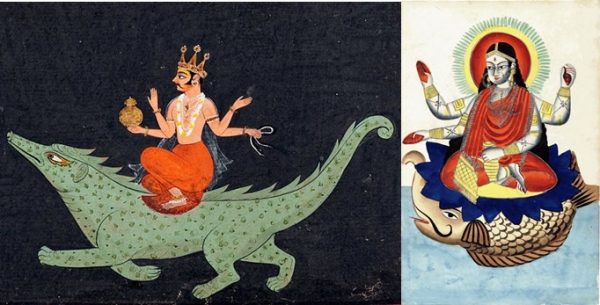
God Varuna on his mount Makara. Ganga (river goddess) on a Makara, note the later elephant like “snout”. Source: Wikipedia and Wikimedia Commons
One can see the creature has morphed to a more fish like composite animals with an elephant snout. That snout is of great importance as a clear identifier. This is the depiction in later ages of a makara we see also on temples in later images. It changed to a composite dragon/crocodile/snake image with an elephant snout even later. The evolution of the dragon is directly related to this and derives from this cultural changes to the Makara creature.
Like in Babylonia, the Mushushu dragon was a composite creature. This goes all the way back to the crocodile Sobek in Egypt (Ptah vehicle), and to the bird/dragon symbolism of Sobek/Horus and indeed the bird dragon symbolism of the Chinese in the phoenix/dragon. All of this is culturally related to each other and has an astronomical basis for this expression of culture into gods and creatures.
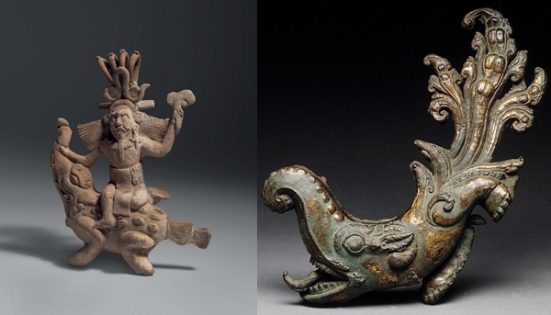
Left: Figurine of the Jaguar God of the Underworld riding a crocodile; similar to the god Varuna riding his Makara. Right: Makara, Nepal. Source: Pinterest and Wikipedia
The South American civilizations depicted the Makara specifically in all of its unique morphology and therefore that that is proof that there is an undeniable cultural link between Asian vedic cultures and south American pyramid cultures. One can dismiss pyramidal structures as “only way to build a tall structure”, but not such an unique composite creature as the Makara for coincidental similarities clearly visible in both cultures.
Let us get a clearer picture of the Makara as such, its depictions in Asian culture and its visual characteristics.
Morphology of the Makara (Key identification of the composite Makara creature)
Before we can compare artistic impressions and identify them as similar we need to understand the key identification points that defines something as such.
– The Makara started as a crocodile where its the vehicle of the god Varuna and relates directly to the Egyptian Sobek/Ptah origins.
– It physically evolved into a composite snake like / dragon like animal always with an elephant like trunk.
– In later ag, it is a composite animal with the body of a crocodile and the snout of an elephant that appears like a “horn”.
– In art and in temples it is depicted often with just two front legs and a vegetation tail or as a long snake like dragon creature.
– Makaras are often seen at entrances to staircases of temples throughout Asia (of later importance in relation to Chichen Itza)
– Or as just a head, water sprout elements on temples. (of relevance later to the western lion that is used like a water sprout in many fountains).
Asian and South American Relations
Pyramids or temples? (Mount Meru)
Now we have established a clear presence of the image of the Makara in Asian cultures. Here is a pyramid from Cambodia:
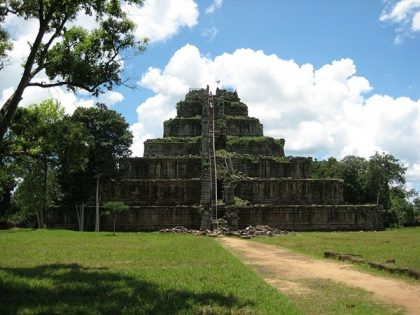
A pyramid in Cambodia, steps and a clear stairway to the top. Phnom Tbeng Meanchey. Source: Wikipedia
It has always been brushed of that the similar pyramidal structures we see in Cambodia compared to south American pyramidal structures, are “coincidence” and the “easiest way to build a taller structure”, that one “would always end up at a pyramidal shape”. Now that is a correct statement. However, an Indian Vaastu Shaastra architect, Dr. V. Ganapati Sthapa, went to the Americas (Sthepatis visit to Maayaland) and made measurements of the buildings. His amazing discovery was that the buildings where build in dimensions and proportions that are in relation with Indian vedic architectural guidelines and measurements. Without going into to much detail regarding that , it already “proofs” by set measurements and proportions, that there must have been cultural relations between these two cultures. For those who still are not convinced, we need more “proof”. What if we found cultural depictions of an unique composite creature like the Makara which has clear identification marks in its composition. If so, to say these two cultures must have come up with the same depiction by accident, is an insult to the human intellect, its history and culture.
Could the “snakes” on Chitzen Itza be transmuted “Makara dragons” as seen on Asian temples. The earlier Thai temple shows a more snake like creature. Compare the image above to the image below of the Indonesian temple. Specifically also pay attention to the swirls at the back of the jaws and the wide open mouths. Would two cultures really build similar buildings with similar decorative elements even on the same places, next to stairways.
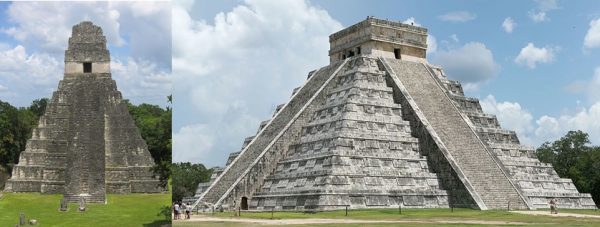
Left: Tikal temple, Mesoamerica. Right: Chichen Itza, Mexico (Identical snake/dragon figures at the side of stairs, symbols we see on Indonesian and Thai temples). Source: Wikipedia
What sets them apart is the trunk like part, which we can see on aztec art. Perhaps that went away due to absence of elephants in South America. Could the Two “snakes on the Chichen Itza pyramid” be identical to the Makara symbolism (like Asian temples)? Even if not so the similarities between the two cultures are striking. Argumentation is provided by comparing these “snakes” to the Aztec calendar stone. It is a well known fact this is a calendar and this that certain portions of this calendar stone is spring, summer, autumn and winter. This is of relevance. Elephants did not exist in South America but other elephant trunk imagery is also seen in the god Chac in Uxmal.
The fact that of the “floral tail” (and the bird on top) is because that part sits in spring of the evolving skies and indicates fertility of the lands. The alligator or monster, eats the land and symbolizes the winter period underworld etc etc. Its an opposite of bird and snake/crocodile, just like in many other cultures, China (phoenix/dragon and egypt Horus/Sobek) wether that is big dipper and draco, the two constellations around the pole. Or Hydra and and opposite (like the rooster constellation) on the church tip) That would need further research.
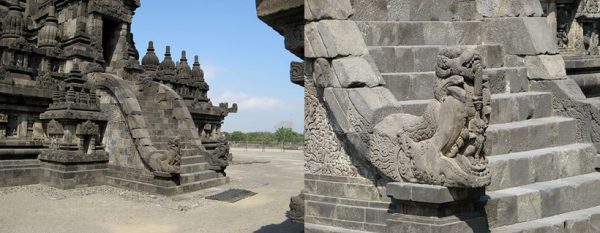
Candi Prambanan, Indonesia, Makara staircase; Source: Wikipedia
There is a second pyramid with two snakes in Chitzen Itza. Also here we see the two pieces extending, oral tradition says its “the breath of life”. These pieces, since they are “loose” are interesting. Are they realy in the right place in front of the chin or perhaps once where horn like trunks. It doesn’t matter much, one can clearly see the similarities between this and the Indonesian temple stairs.
The Aztec Calendar
The Aztec calendar depicts the great goddess in the centre, the milky way, the origin center of creation. The one that gives and takes life. Similar symbolism is found in the Greeks with the virgin and Medusa. Hence the similar symbolism, (good and evil). There are numerous Mayan images, like the Aztec calendar that look very close to Medusa the gorgon as all representations of Kala Makara. On the Aztec Calendar the two “snakes” are clearly “Asian style” Makaras with a trunked elephant snout and two frontal legs.
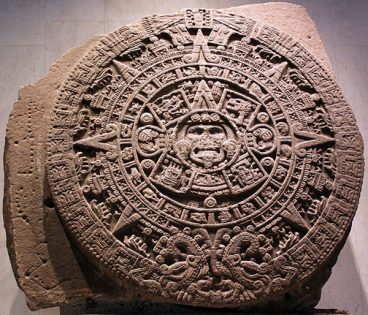
Aztec calendar stone
Izapa stele 25 is identical to Tibetan and other Asian representations of the Makara and here in this research firstly identified as such. A crocodile with a floral tale, an astronomical depiction of our revolving skies in ancient days. The bird (on top) and the dragon in tree form, hence why the Mayas revered the Ceiba tree as tree of life as the spikes resembled the alligators back. Stele 25 is another undeniable depiction in favour of a South America Makara, with only two front legs and a floral vegetation tale.
Astronomical References in the Vedas
The sacred Hindu text Shatpatha Brhamana mentions an idea of a mythical planetary system called Shishumara.This is a discription of the sky, the Makara creature in particular. 14-14 stars refers to the lunar mansions. It’s the milkyway figure that is described here. Exactly like Izapa stele 25. The tree of life or our revolving skies. It is described as “having its head downward and its body coiled. On the end of its tail is the planet of Dhruva.
This is the bird in the tree of Izapa stele 25, the little dipper containing Polaris. Its also the top large star in the western christmas tree, which, is a representation of the tree of life as well. Its lights and balls the other stars. On the body of its tail are the planets of demigods Prajapati, Agni , Indra and Dharma, and at the base of its tail are the planets of the demigods Dhata and Vidhata. Where the hips might be on the Shishumara are the seven saintly sages like Vasinora and Aigira.
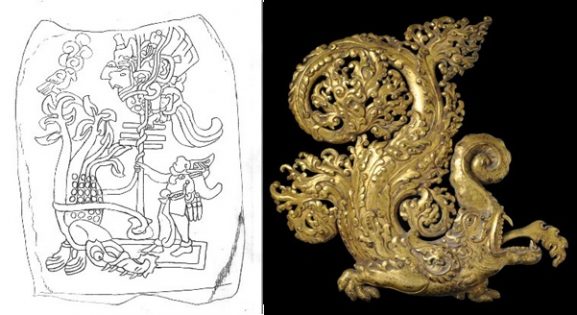
Left: Stele 25 Izapa; Source Wikipedia. Right: A Gilt Bronze Makara, 13th/14th Century (note the two front legs and the vegetation tale), Tibet. Source: michaelbackmanltd.com
The coiled body of the Shishumar-cakra turns toward its right side, on which the fourteen constellations from Abhijit to Punarvasu are located. On its left side are the fourteen stars from Punya to Uttaranoaha. Thus, its body is balanced because its sides are occupied by an equal number of stars.On the back of the Shishumara is a group of stars known as the Ajavethe, and on its abdomen is the Ganges that flows into the sky.
The Makara is ALWAYS related to a calender, time system or the constellations. Its a total sky representation captured into a single composite animal. It’s the bottom constellation of crocodile(snake) or earth and the top the bird (eagle, phoenix, quetzal). Together it makes, the feathered serpent. It morphed from crocodile to dragon/snake and from falcon to eagle/phoenix/heron (all snake easters) but the basis is the same Just like ancient Egypt where its Sobek the crocodile and Horus the Falcon, hence the temples being linked to Sobek-Horus and it makes sense that there where temples like that, a temple to time , the creation and destruction itself.
Jonah and the Fish in Indian and Mayan Art?
This later gave rise to the biblical stories of Jonah and the fish as seen here below:
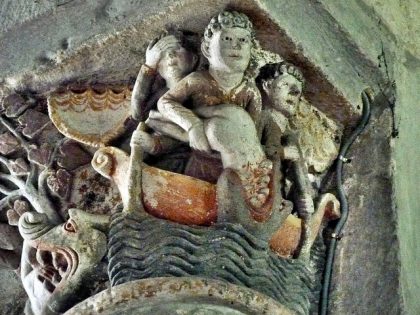
The story of Jonah and the fish on a capitel in the monastery of Mozac. Note the following. The specific Makara snout but also the vegetation. The great fish, often seen as a whale, here is a real sea monster. Source: flickr
The knowledge came with the crusaders visiting far lands and where adopted and changed to their original meaning by the church. However one can clearly see the Makara origins, but for those who can’t see “the person in the fish” here are some Indian examples as well and conclude with the Aztec figure “in the fish”.
Just like the Aztec Calendar stone one sees, the figures in the mouth of the Makara creature in Indian art. A drawing based on the Calendar stone shows the two front legs and the elephant snout better. These are not snakes but Makara “dragons” as seen in Asian art and relate to the creation story (and astronomy of the year just like it does in the Christian Bible who got this exact story from the ancient cultures and remodeled it and did a poor job on it on the monastery image where it’s clearly an Asian looking Makara.
Other Makara Symbology in South America
One could still stick to the Chichen Itza figures being snakes, as, no legs are seen on Chitzen Itza. However, presenting and identifying Stele 25 of Izapa as a Makara figure start to shoot holes in the currently accepted academic views that there are no relations between South American and Asian civilizations as that is a clear match to the Tibetan and other Asian depictions. The snout on the Aztec stone and the legs are also hard to ignore.
This research argues a Vedic origin of the Americas, with clear proof of cultural similarities between these two continents. Besides a few authors who have tried to argue in favor of Asian origins of the south American civilizations, this has gotten very little to no attention from the world. It would mean, the east discovered the Americas and not the west. The fairy tale of Columbus should be put to rest once and for all, as he discovered an advanced cultural history in the Americas that had to come from somewhere.
Well, it came from Asia, who by the way also counted in a moon calendar.For those who still deny the figures on the calendar stone are Makaras perhaps, so let us strengthen the case for that by showing more cultural depictions of Makara’s in South American civilization. Their visual appearance is so unique, that, once one has identified them and seen them, we start seeing them in numerous other places, even in similar depictions as the Asian Buddha images where they rest on the shoulders. There is a reason for that as well. Again they come in pairs one points to the east and one to the west in this symbology, as it is like the Egyptian Aker (where this function is held by lions) guarding the eastern and western horizon of the ecliptic. We see this, and the two makaras as ecliptic also on Pakals tomb lid.
This is where it starts to get interesting, as we have seen this “Makara symbolism” before on the shoulders of the Buddha. What we see on Pakals tomb lid is just another representation of a calendar, the tree of life, the cross, where the horizontal bar represents the ecliptic. This is exactly what the Christian church cross is, yet the church got the information “from the east” and the Mayans, technically “from the west.” The bird on top again is also visible, just like stele 25 of Izapa. This whole tree of life, pillar of sky is an astronomical depiction of the revolving skies. The bird and this whole depiction identical to Sumerian depictions of the tree of life with the bird on top.
Makaras, like the Egyptian Aker, as guardians of the ecliptic and creation story
Let us get back to the Makara in South America and the similarities of their gods showing the ecliptic.In Copan, Stele B we again will find the stylized Makara, this time in the hands of their so called “maize god”. Again, one to the left and one to the right identifying the ecliptic. This research argues that the Makara is an evolved form of the Aker symbol of Egypt, that combined with snakes evolved to Sumeria into the Mushushu and via India into the dragon/Makara symbolism guarding the horizons. So in the west we will see two lions on each side of a goddess as representation of the milky way, the creator etc and in the east we see the mount symbolism in the form of Meru with the two dragons on the side basically symbolizing exactly the same. There are numerous other examples in South America making the Makara as such an integral part of their civilization, just like in Asia. The story of the Makara and the maize god in it is linked to their creation story.
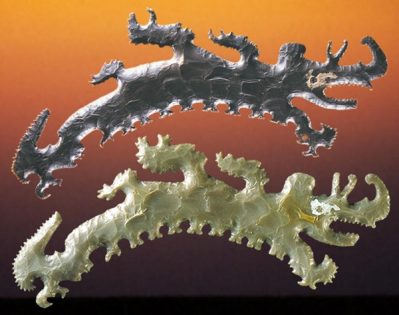
Mayan Eccentric Flint. Clearly and without a doubt a depiction of a makara. Source: lithiccastinglab.com
This is a pretty clear representation of the Makara. Not only that it explains why there is a figure seen in its mouth. The exact same symbolism, of a figure emerging from a makara has been seen in India and provided earlier in this paper. Not only that the date of 3114BC of their creation myth clearly aligns with the Indian Yuga cycles of time and the story is identical to the Story of Manu, the first man.
New Zealand
New Zealand’s Maori had an Indian origin and influence. Still there is a town called Makara in New Zealand, the Maori call the north island, according to their creation myth, “the head of the fish”. One needs to see a map of the New Zealand north island to understand why. Here is a web article for the full story.
With a bit of imagination it is truly and exactly the “head of the makara” or great fish in shape with the long snout. This also goes beyond the scope of this paper but points to an Indian relation of the Maori culture, which would be logical if they could sail to the Americas. The fish / Makara link is a link to a lost past.
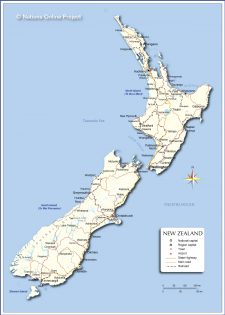
Source: Nations Online
How did the great goddess symbolism / milkyway evolve in the West? (The migration of symbols)
It can be debated, if civilization started in Egypt,moved east, through India and then to south America, or that a Vedic Indian civilization was the basis and the Egyptian pyramids are mount Meru, like Su-Meru, which means good Meru in Sanskrit. Going more to the West the image of the revolving stars evolved into Potnia Theron, Cybele, the lady of the two lions, The mistress of the animals, the tree of life but also into Medusa, the Gorgon etc .etc. There are a lot of similarities between the Gorgon image with the stuck out tongue, the Maori traditions of doing so and the Medusa Gorgon images.
The Makaras or two sides of the year, are represented as two lions in the West.
Aker, the two lions guardian of the horizons or the lady with the two snakes. The snakes and lions together of the Egyptians and Minoans evolved into the Makara going more eastwards eventually into dragons and Fu Lions. The two lions guarding the “tree of Life” or universe from which everything gets created and also destroyed in a never ending cycle of life death and rebirth.
In the west we see the great goddess with lions. Cybele, the great mother (milkyway/god), Astarte and many others. The goddess in this case holding lions, the opening at her womb can also be seen (unidentified as such yet) in Aslantas, Turkey. The water sprouting lions often seen in fountains are identical to the water sprouting makara’s in India. They symbolize the river or waters in the sky as the ancient saw the sky/milkyway as an ocean/river. Hence that the Goddess Ganga rode a makara.
Besides the goddess here holding the two makaras upright instead of nose down, as in later lions, we also still see the two “lions” at the bottom watching the ecliptic like aker and this eventually is the basis for the royal crests and the eagle watching left and right (to the ecliptic). The goddess in the west was holding snakes and lions. Aker, the lions, was watching the horizon in Egypt, yet in South America and Asia, it was the two makaras. Yet sometimes we see two Fu lions in front of temples and sometime we see the dragons/makaras as guardians. They guard the symbol of creation, the mount, or milky way mount Meru.
After the crusaders took the imagery of the Mushushu and Makara to the west, the dragon symbolism of the west was born out of this. In Rosslyn, again we see the tree of life in the form of a pillar, with the famous Rosslyns apprentice pillar a symbol of the tree of life, its dragons at the bottom and swirls of vegetation around it, which is a clear link. It is also seen in Norsk symbolism as Yggdrasil the world tree with the great dragon/snake at the bottom of it. Hence we see the floral dragon or orkney, the maeshowe dragonat the tumulus as a similar representation of this world tree dragon/crocodile. This eventualy, is a representation of the Makara with its floral tail.
The origin of the Starbucks logo and its relation to the makara, the Aztec calendar and its Indian origins.
Many people think the Starbucks logo is based on the Siren of the 15th century. Yet this particular image comes from earlier Indian symbology (around 100 AD). Her two fish tails, are actually two makaras eating her legs and as such is identical to the symbolism of the Aztec calendar stone.
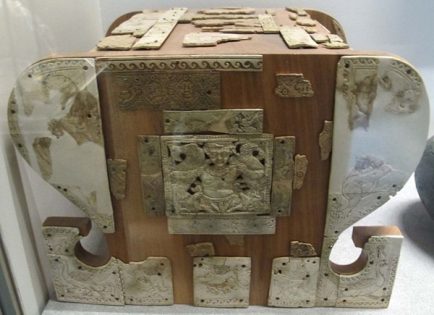
Makaras with fish-tails and emergence of a smith, ivory-carver. Source: Wikipedia
The image above is ivory from a find in northern India is asserted here to be the earliest depiction of the Starbucks logo. With a bit of imagination one can link this very good to the Aztec calendar stone. Lower the female head to the center and there you have, the Aztec calendar with the two makaras on the sides depicted slightly different but awkwardly similar in the same breath. She is the milky way, the great goddess, maiden and gorgon Medusa in one. She who takes lives and gives life to earth. With the polestar on top just like the earlier depiction on the fountain in. That image, is on your cup of Starbucks coffee. The oldest representation is not the 15th century Siren, but the one from the Begram Ivories in India and the Scythian Gold ornament from Tillia Tepe, Afghanistan.

Source: logodesignlove.com
The likeness of South American art of the Kala Makara to the Hindu art is undeniable. The snake devouring monster is usualy seen above the door. Again the Makaras at the stairways. The presence of a “door monster” in Mayan art was noted by Richard Cassaro in his 2012 web article however no further information was provided besides pointing this resemblance.
This research aimed to shift academic perception, that all civilizations evolved independently and that there is no relation between Asian and South American civilizations. It tried to prove via the Makara symbolism a Vedic seafaring origin of civilization. The many pointers are obvious when highlighted. The Makara was a key identifier. Not only its explicit morphology and incorporation in culture, but also its specific meaning in both cultures as relation to astronomy and constellations.
Read the original version of this research paper here.
I would like to thank my wife, for her patience in me researching the ancient world and my countless hours I spend in the evenings on my mobile devices researching various subjects.
Credit
[1] Richard Cassaro
[2] Hinduwisdom
(naming numerous older authors postulating the Asian America Theories, article mirrored here.
[3] Pierre Honore
[4] Gordon F. Ekholm
[5] Gordon R. Willey.

